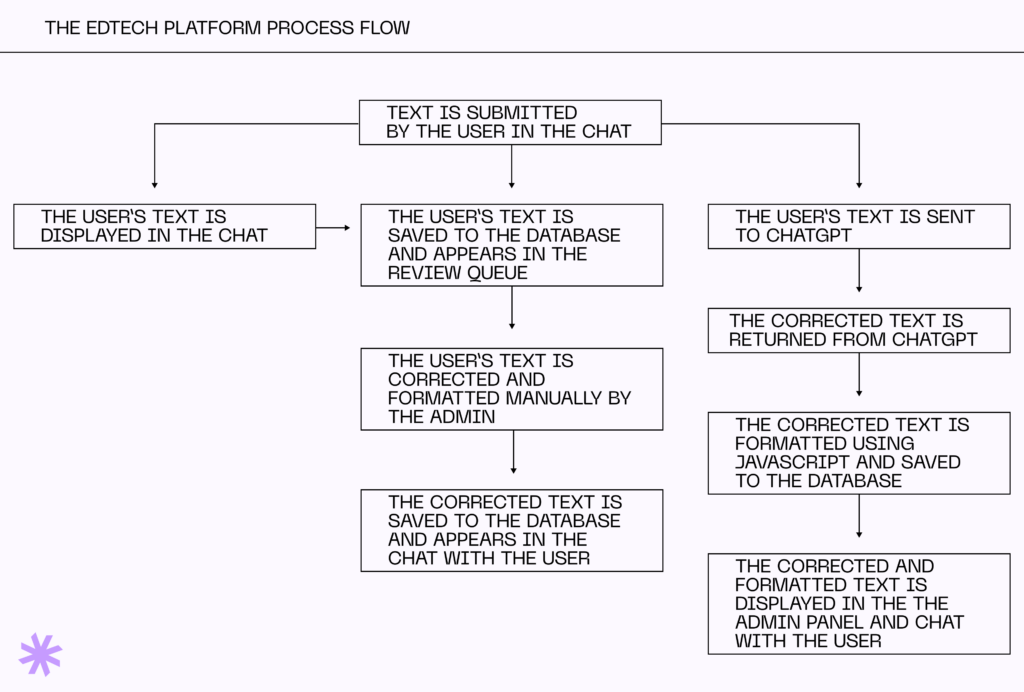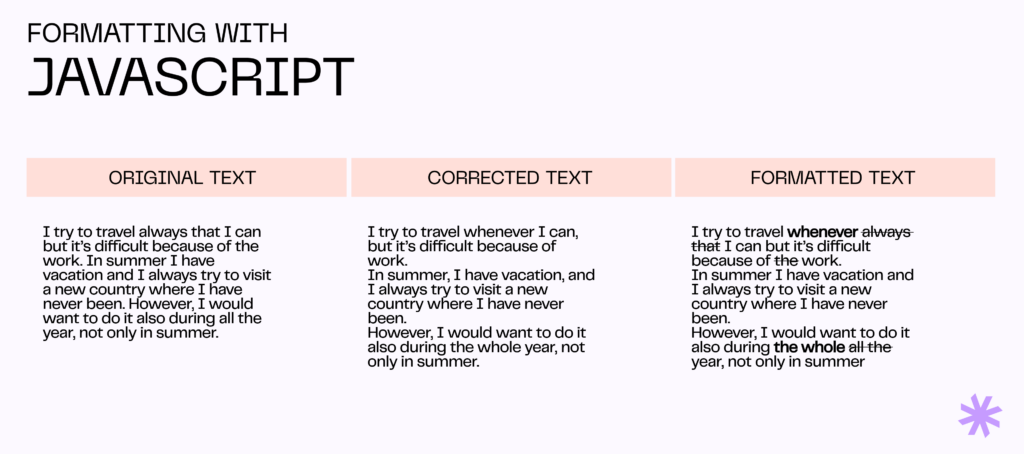There is a wide range of self-learning tools available. Learners can use gamified apps to master vocabulary and grammar, flashcards to memorize new terms, audio lesson apps to enhance listening comprehension, pronunciation apps to improve their speaking skills, and more.
However, a common challenge for self-learners is the lack of a structured approach, as different tools follow different programs or leave education planning entirely up to the user.
So today, we invite you to explore a solution to this issue through a strategic partnership between an EdTech business and Syndicode.
The client prefers not to reveal the platform’s name at this point. Still, we can certainly share the significant impact made possible by our generative AI services.
A market gap: personalized insights into learning opportunities
A visionary EdTech platform partnered with the technical masterminds at Syndicode to bring structure to language learning by adding ChatGPT. They leveraged large language model services to deliver personalized insights at scale.
The platform helps users identify weak spots in their knowledge by prompting them to write short answers to randomly generated questions. It then analyzes these responses for grammatical, lexical, and punctuation errors, providing a corrected, interactive version of the text with detailed explanations.
This way, the app highlights areas needing improvement, allowing users to refocus their attention and prioritize their learning efforts effectively.

What features does ChatGPT bring to the platform?
Automation
With the Syndicode team integrating ChatGPT, the EdTech platform transitioned from manual operations to a chatbot-powered workflow. This shift reduced the need for additional agents while maintaining high-quality responses.
Enhanced user satisfaction
While human-generated responses are highly valued, users expect rapid replies to their inquiries. ChatGPT ensures users receive instant answers, while human reviewers can assess the bot’s work at their own pace. This feature is a game changer for the business, enhancing service quality and building trust with the audience.
24/7 availability
ChatGPT operates round the clock, making the platform accessible to learners across different time zones and work schedules. Users can now receive learning help at any time of day.
Language support
ChatGPT is multilingual, enabling the platform to offer more language choices in the future.
Enhance your website with AI
At Syndicode, you can find expert AI/ML developers who will elevate your solution with AI-powered capabilities. Tell us briefly about your project and the challenges to get started.
Contact usPreparing the platform for ChatGPT integration
Our team had several considerations to take into account before beginning the work:
- By the client’s design, the ChatGPT integration was intended to complement the existing workflow, providing an alternative way to process user prompts. It, therefore, needed to seamlessly integrate into the chat without causing any disruptions in performance or UX.

- Since ChatGPT is a general-purpose model, it needs customization to perform specific tasks. In this project, a carefully crafted prompt was sufficient to effectively guide the AI.
- Another crucial consideration for our team was determining the best method to integrate ChatGPT into the website.
Different integration options
- API integration is a hands-on approach that offers complete control and customization over ChatGPT. It’s quick, easy, and requires minimal technical knowledge for maintenance.
- Pre-built widget integration comes with ready-made templates and settings but offers limited customization.
- Custom backend implementation provides the most control over data handling, security, and performance optimizations. However, this method requires more effort to maintain than others.
Since the task wasn’t complex and didn’t require extensive customization, a custom implementation would have been overkill. Meanwhile, pre-built widgets lacked the necessary functionality and included unnecessary extra features. Therefore, we opted for ChatGPT integration via API.
Integrating ChatGPT with the EdTech platform
Integrating ChatGPT with the language learning website was a key step in enhancing its capabilities. The integration process was as follows:
- Get access to ChatGPT
The client created an account with OpenAI and signed up for ChatGPT services. Next, they received an API key and provided it to the Syndicode team.
- Paste the code
Our engineers inserted the API key into the relevant code section of the platform, ensuring seamless communication with the chatbot. They verified that the integration functioned correctly without any errors.
- Tailor chatGPT for the task
Using a prompt provided by the client, we tailored the chatbot to perform specific manipulations with user-provided content. The prompt detailed the chatbot’s focus areas and limitations.
- Front-end integration
Since ChatGPT cannot format text according to the platform’s requirements, our engineers came up with an additional front-end solution. At the client’s request, we used JavaScript to ensure the text output was indistinguishable from that formatted by a human linguist.

Takeaway: ChatGPT is a gamechanger in language learning
The EdTech platform has significantly enhanced its capabilities. Thanks to ChatGPT automation, the website now provides instant and accurate corrections of user prompts. The detailed explanations of the corrections highlight areas for improvement in the user’s language learning journey and help them refine their learning plan.
This project is just one example of how integrating ChatGPT into your website can create a better user experience. If you’re ready to give it a try, check out our AI/ML development services and contact us for technical assistance!
Frequently asked questions
-
What are the benefits of adding ChatGPT to a website?
Adding ChatGPT to a website can enhance user engagement by providing instant, human-like responses to queries. This capability reduces the need for extensive human support, lowering operational costs. ChatGPT can also handle a wide range of tasks, from answering frequently asked questions to assisting with complex queries, ensuring users receive accurate and timely information. Additionally, it operates 24/7, ensuring visitors can interact with the site anytime, regardless of time zones. This constant availability can increase customer satisfaction and loyalty. Furthermore, ChatGPT’s ability to learn from interactions continually improves, offering better and more personalized responses over time. This adaptability makes it a valuable asset for businesses looking to streamline their online operations and enhance customer support.
-
What apps can be connected with ChatGPT?
ChatGPT can be integrated with a wide variety of applications, including websites, mobile apps, and everything in between. The most common use cases are as follows. Customer support platforms use ChatGPT to respond instantly to user inquiries, improving service efficiency. E-commerce websites benefit from ChatGPT by offering personalized shopping assistance and handling customer service tasks. Educational apps can integrate ChatGPT to offer tutoring, answer questions, and explain various topics. Content creation tools can use ChatGPT to generate ideas, write articles, or assist with editing and proofreading. Social media platforms can also incorporate ChatGPT to engage with users, manage comments, and provide support. Healthcare apps can use ChatGPT for preliminary patient interactions, symptom checking, and answering common medical questions. Finally, productivity apps can also leverage ChatGPT for scheduling, reminders, and task management, making it a versatile tool across multiple industries.
-
What are the challenges of adding ChatGPT to educational solutions?
One primary concern when integrating ChatGPT into educational websites is ensuring the accuracy and reliability of the information provided, as ChatGPT can sometimes generate incorrect or misleading responses. This is particularly crucial in an educational context where students rely on accurate information. Additionally, there’s a need for careful moderation to prevent the dissemination of inappropriate or harmful content. Customizing ChatGPT to align with specific curricula and educational standards can also be challenging, requiring significant effort to tailor the model’s responses. Privacy and data security are other critical issues, as the system must handle sensitive student information responsibly. Ensuring equitable access and avoiding biases in the AI’s responses are also essential to providing a fair learning environment. Addressing these challenges requires a thoughtful implementation strategy, continuous monitoring, and regular updates to maintain the tool’s effectiveness and safety in educational settings. Therefore, if your solution involves AI integration, you should think about partnering with a reliable IT maintenance and support services provider.
-
How long does it take to integrate ChatGPT with a website?
The time required for integrating ChatGPT into a website depends on the site’s complexity, specific use cases, and the level of customization needed. In the example described in the blog post, the integration took 16 hours, given the prompt provided and the technical stack determined by the client. Generally, for a basic integration using pre-built APIs, the process can take anywhere from a few days to a couple of weeks. This involves setting up the API, incorporating it into the website’s backend, and performing initial testing to ensure functionality. For more complex implementations that require significant customization, such as tailoring ChatGPT to specific workflows, creating custom prompts, or integrating it with other backend systems, the process can take several weeks to a few months. This extended timeframe accounts for additional tasks such as designing the user interface, conducting thorough testing and debugging, ensuring data privacy and security compliance, and training the model to handle specific types of user interactions effectively. That said, different software development teams might give varying time estimates for the same project due to the use of different development methods. To find out how long it will take to implement your AI integration project with Synficode, please contact us by filling out a short form.
